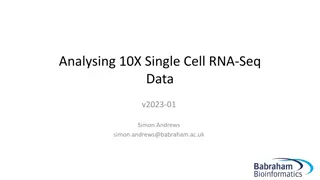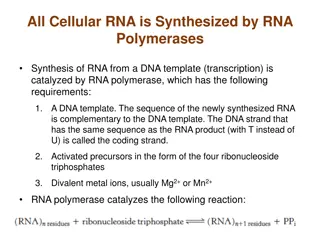RNA 3D Motif Analysis: Novel Sequence Variants Identification
A research project at Bowling Green State University aims to identify 3D motifs in RNA hairpin and internal loops using sequence and secondary structure information. The study focuses on finding likely sequence variants of known motifs, leveraging geometric considerations and basepair isostericity for predictions. The project utilizes RMDetect to analyze trusted alignments and update a comprehensive RNA 3D Motif Atlas regularly. Physical basis models predict variability in basepair combinations, contributing to the understanding of RNA loop structures.
- RNA 3D motifs
- Sequence variants
- RNA structure analysis
- Geometric considerations
- Basepair conservation
Download Presentation

Please find below an Image/Link to download the presentation.
The content on the website is provided AS IS for your information and personal use only. It may not be sold, licensed, or shared on other websites without obtaining consent from the author. Download presentation by click this link. If you encounter any issues during the download, it is possible that the publisher has removed the file from their server.
E N D
Presentation Transcript
Identifying novel sequence variants of RNA 3D motifs Craig L. Zirbel Bowling Green State University Bowling Green, Ohio Goal: Given the sequence and secondary structure of an RNA, identify known 3D motifs in the hairpin and internal loops.
RNA hairpin and internal loops are structured in 3D T-loop with two bulged bases hairpin loop; HL_72498.12 tSH-inserted-tHW internal loop; IL_93424.4
RNA 3D Motif Atlas Instances in each motif group share the same overall geometry and the same pattern* of basepairs. Updated every four weeks to present the most up to date collection of motifs.
Ideal situation exact sequence match Occasionally it will happen that the sequence of a loop in a new RNA sequence exactly matches a known RNA loop. Only about 1500 unique internal loop sequences across 276 motif groups, and fewer still when you pay attention only to the interior (non-Watson-Crick) part of the loop. Exact sequence matches will be rare.
Finding likely sequence variants of known 3D motifs RMDetect (Cruz and Westhof, Nature 2011) Use sequence variants in trusted alignments Limited availability of such alignments, due to Circularity challenge: how to align well, except by understanding the 3D motif the sequences form? Our approach: Use geometric considerations to predict likely sequence variants Test our predictions against alignments
Physical basis for predicting variability Basepair isostericity (Stombaugh, Zirbel, Westhof, Leontis NAR 2009) Basepair family tends to be conserved at corresponding positions in homologues When base combinations change, the new basepair tends to still have similar backbone connections AU, UA, GC, CG cis WC/WC basepairs reign supreme tHS AG and AA, Superimposed: Superposition and heat map from the RNA Basepair Catalog
Physical basis for predicting variability Base-phosphate interactions (Zirbel, Sponer, Sponer, Stombaugh, Leontis NAR 2009)
Physical basis for predicting variability Location and number of insertions in 3D motif instances Alignment of 3D sequences from motif group IL_93424.4 to the 9 conserved positions in the motif group. Note the variable-length insertions between positions 2 and 3, and between positions 3 and 4. Strand 1 Strand 2
Probabilistic model SCFG for nested basepairs, fixed bases, variable-length insertions Instance IL_2AW7_041 from IL_95652.3 Sequence: GGAGUACG*UAAAAC
Probabilistic model Markov random field / Gibbs ensemble for base triples and locally crossing basepairs Instance IL_2AW7_041 from IL_95652.3 Sequence: GGAGUACG*UAAAAC
Availability JAR3D (Java-based Alignment using RNA 3D structure) jar file and model files are available at http://rna.bgsu.edu/data/jar3d/models/ Source code is available at https://github.com/BGSU-RNA/JAR3D JAR3D web server is available at http://rna.bgsu.edu/jar3d/
Alignments via JAR3D web server Sequences from a multiple sequence alignment of instance IL_2AW7_041 from motif group IL_95652.3, having 14 nucleotides, aligned to the model for motif group IL_97191.1, a Sarcin- Ricin motif with 13 nucleotides.
Scoring sequences against a model Score sequences against the model for IL_93434.4 Sequence Alignment score Deficit Best 3D sequence CGAUG*CUAAG -5.412 0 Novel sequence #1 UGAUG*CUAGC -12.959 7.546 Interior edit distance = 1 Minimum interior edit distance = 1
Scoring sequences, acceptance region Novel sequence Cutoff score 6.4 tells how far into the acceptance region the sequence falls Best 3D sequence
Trouble with alignment sequences Alignment sequence GUCCC*GAACG Alignment sequence CAAUG*CUAGC Alignment sequence UGAUG*CUAGC Best 3D sequence
3D, alignment, random sequences Note: Dots are shifted to the right by uniformly- distributed numbers to aid visualization
3D, alignment, random sequences Note: Acceptance region is based only on the randomly- generated sequences, 4% match rate
Match rate of randomly-generated sequences on 200+ models High match rate for short sequences, like single base bulges such as GAC*GC High match rate for symmetric internal loops like CGAAU*ACAAG Matches 16 motif groups 22 motif groups have sequences this length Sequence can also match as ACAAG*CGAAU, So 44 possibilities to match Low match rate for longer loops
Comparison to RMDetect acceptance CCUAGUAC*GGAACCG (------(*)-----) JAR3D input RMDetect input Good agreement on G-bulge (Sarcin-Ricin) Tandem sheared (tSH-tHS) JAR3D identifies more Kink turn C-loop GCGCCCUAGUACGCGAGAGCGGAACCGGCGC (((((------(((----)))-----)))))
Test ability to recognize novel sequences Take one 3D instance from motif group G Retrieve columns of a multiple sequence alignment corresponding to the instance, from Silva, RNAStar, GreenGenes Exclude any rows whose interior sequence exactly matches a known 3D instance from group G Score sequences against all 200+ motif groups, keep those which accept it, and match to the group having the highest alignment score (log of generation probability) Record the percentage of novel alignment sequences which are matched to original motif group G
Test ability to recognize novel sequences Each dot is one alignment extract Horizontal tells how many nucleotides are in the motif Vertical tells what percentage of rows are matched to the original motif group Dots are colored by average minimum internal edit distance Black curve is a running average All novel sequences no exact interior sequence matches
Test ability to recognize novel sequences Matching an equivalent motif is counted as a success Omit alignment sequences whose flanking pairs are not AU, GC, or GU
Multiple sequences of the same motif With RNA double helices, covariation gives you additional confidence With internal and hairpin loops, each distinct interior sequence narrows the range of possible motifs The probability of getting the correct motif relaxes to 1 exponentially quickly as the number of distinct sequences increases*
Acknowledgments Development Michael Sarver (SCFG development) Megan Pirrung (Java coding) James Roll (SCFG development, Java, webserver) Blake Sweeney (webserver) Anton Petrov (RNA 3D Motif Atlas) Neocles Leontis (inspiration and guidance) Testing Biao Ding, in memoriam (RNA viroid) Corinna Theis, Jan Gorodkin (genome scanning) Peter Kerepdjiev at TBI (3D structure prediction) Rhiju Das (loop prediction) Hosting Ivo Hofacker and the TBI (sabbatical 2013-2014)























